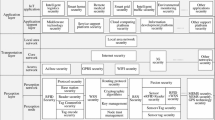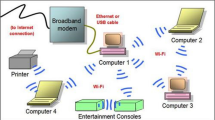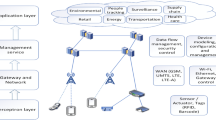Abstract
This paper addresses the problem of secure localization in hostile environments. We propose a secure and efficient localization scheme to enhance the security function of Ultra-Wideband sensor networks. The method does not only provide strong security against distance reduction attacks, but also distance enlargement attacks. Furthermore, it is a device-independent scheme with strong function of more accurate localization. Based on Petri net, an attack-driven model is also developed. , which provides a formal method to verify our scheme when considering distance enlargement attacks. State analysis, which proves that the potential insecure states are unreachable, shows that the model can provide strong security in the environment with these attacks.
Similar content being viewed by others
References
Lie J.P., See C.M., Ng B.P. (2005) UWB ranging with high robustness against dominant jammer and multipath. IEEE Microwave and Wireless Components Letters 15(12): 907–909
Tchere, G. F., Ubolkosold, P., Knedlik, S., & Loffeld O. (2007). Communication and TOA estimation with differential impulse radio UWB systems. In The 4th Workshop on Positioning, Navigation and Communication (WPNC’ 07), pp. 87–95.
Yong, X., Hua, L., Fei, H., & Qiu, W. (2006). TDOA algorithm for UWB localization in mobile environments. In Proceedings of International wireless Communications, Networking and Mobile Computing, 2006 (WICOM 2006), pp. 1–5.
Tuchler, M., Schwarz, V., & Huber, A.(2005). Location accuracy of an UWB localization system in a multi-path environment. In Proceeding of 2005 IEEE International Conference on Ultra-Wideband (ICU 2005), pp. 414–419.
Zhang, Y., & Zhao, J. (2005). Indoor localization using time difference of arrival and time-hopping impulse radio. In Proceedings of 2005 IEEE International Symposium on Communications and Information Technology (ISCIT 2005), 2, pp. 964–967.
Jourdan, D. B., & Deyst, J. J. (2005). Monte Carlo localization in dense multipath environments using UWB ranging. In Proceeding of 2005 IEEE International Conference on Ultra-Wideband (ICU 2005), pp. 314–319.
Liu, D., Ning, P., & Du, W. (2005). Attack-resistant location estimation in wireless sensor networks. In Proceedings of the Fourth International Symposium on Information Processing in Sensor Networks (IPSN ’05), pp. 99–106.
Li, Z., Trappe, W., Zhang, Y., & Nath, B. (2005). Robust statistical methods for securing wireless localization in sensor networks. In Proceedings of the Fourth International Symposium on Information Processing in Sensor Networks (IPSN’05), pp. 91–98.
Wang, C., Liu, A., & Ning, P. (2007). Cluster-based minimum mean square estimation for secure and resilient localization in wireless sensor networks. In 2007 International Conference on Wireless algorithms, Systems and Applications.(WASA 2007), pp. 29–37.
Capkun, S., & Hubaux, J. (2005). Secure positioning of wireless devices with application to sensor networks. In Proceedings of 24th Annual Joint Conference of the IEEE Computer and Communications Societies (IEEE InfoCom’05), 3, pp. 1917–1928.
Lazos L., Poovendran R. (2005) Serloc: Robust localization for wireless sensor networks. ACM Transactions on Sensor Networks 1(1): 73–100
Lazos, L., Capkun, S., Poovendran, R., & Rope. (2005). Robust position estimation in wireless sensor networks. In Proceedings of the Fourth International Symposium on Information Processing in Sensor Networks (IPSN ’05), pp. 324–331.
Zhang Y., Liu W., Fang Y., Wu D. (2006) Secure localization and authentication in ultra-wideband sensor networks. IEEE Journal on Selected areas in communications 24(4): 829–835
Savvides, A., Han, C., & Srivastava, M. (2001). Dynamic fine-grained localization in ad-hoc networks of sensors. In Proceedings of ACM MobiCom 2001, pp. 166–179.
Liu, D., Ning, P., & Du, W. (2005). Detecting malicious beacon nodes for secure location discovery in wireless sensor networks. In Proceedings of 25th ICDCS, pp. 609–619.
Srinivasan, A., Teitelbaum, J., & Wu, J. (2006). DRBTS: distributed reputation-based beacon trust system. In Proceedings of 2nd IEEE DASC, pp. 277–283.
Srinivasan, A., & Wu, J. (2007). A survey on secure localization in wireless sensor networks (Accepted to appear). In B. Furht (Ed.), Encyclopedia of wireless and mobile communications, CRC Press, Taylor and Francis Group, pp. 12–14.
Xu D., Ygard K.E. (2006) Threat-driven modeling and verification of secure software using aspect-oriented Petri nets. IEEE Transactions on Software Engineering 32(4): 265–278
Murata T. (1989) Petri nets: Properties, analysis and applications. In Proceedings of the IEEE 77(4): 541–580
Author information
Authors and Affiliations
Corresponding author
Rights and permissions
About this article
Cite this article
He, D., Cui, L., Huang, H. et al. Secure and Efficient Localization Scheme in Ultra-Wideband Sensor Networks. Wireless Pers Commun 50, 545–561 (2009). https://doi.org/10.1007/s11277-008-9623-x
Received:
Accepted:
Published:
Issue Date:
DOI: https://doi.org/10.1007/s11277-008-9623-x




